The Damage and Impulse Transfer Characteristics of Flexible Steel V-Structures with Large Bend Radii
Abstract
1. Introduction
2. Materials and Methods
2.1. Specimen Design and Selection
2.2. Explosion Test Method
2.3. Experimental Instrumentation and Measurements
3. Experimental Results
3.1. Permanent Damage Characteristics
3.1.1. 105° Internal Angle V-Structures
3.1.2. 120° Internal Angle V-Structures
3.2. Impulse Transfer and Permanent Displacement
3.3. Transient Response
4. Modelling Approach and Results
4.1. Computational Simulation Approach
4.2. Computational Simulation Results
4.3. Response Characteristics of V-Structures Subjected to Localized Blast Loads
5. Conclusions
Author Contributions
Funding
Institutional Review Board Statement
Informed Consent Statement
Data Availability Statement
Acknowledgments
Conflicts of Interest
References
- Army Technology, Cougar MRAP. 2021. Available online: https://www.army-technology.com/projects/cougar-mrap/ (accessed on 28 October 2022).
- Stiff, P. Taming the Landmine; Galago: Johannesburg, South Africa, 1986. [Google Scholar]
- US Department of Defense, Press Release, Washington, US, 14 October 2022. Available online: https://www.defense.gov/News/Releases/Release/Article/3189571/725-million-in-additional-security-assistance-for-ukraine/ (accessed on 28 October 2022).
- Shekhar, V.R.; Langdon, G.S. The effect of the bend radius on the impulse transfer characteristics of V-hulls: Numerical simulations. Int. J. Prot. Struct. 2020, 11, 69–89. [Google Scholar]
- Chung Kim Yuen, S.; Langdon, G.S.; Nurick, G.N.; Pickering, E.G.; Balden, V.H. Response of V-shape plates to localised blast load: Experiments and numerical simulation. Int. J. Impact Eng. 2012, 46, 97–109. [Google Scholar] [CrossRef]
- Pakulski, K.; Johnson, J.; Giffin, R.; Lo, M.; Wise, D.; St Onge, P.; Balcena, P.; Fridie, M.; Barrett, A. Prevention of Injury in Mine Resistant Ambush Protected (MRAP) Vehicle Accidents; US Army Aeromedical Research Laboratory Report No. 2013-14; US Army Aeromedical Research Laboratory: Fort Rucker, AL, USA, 2013. [Google Scholar]
- Ramasamy, A.; Hill, A.M.; Hepper, A.E.; Bull, A.M.J.; Clasper, J.C. Blast mines: Physics, injury mechanisms and vehicle protection. J. R. Army Med. Corps 2009, 155, 258–264. [Google Scholar] [CrossRef]
- Langdon, G.S.; Chung Kim Yuen, S.; Nurick, G.N.; Naidoo, K. Some insights into the response of ‘shallow V shape’ structures to air blast loading. Proc. Indian Natl. Sci. Acad. 2013, 79, 695–703. [Google Scholar] [CrossRef]
- Zhao, X.; Shultis, G.; Hurley, R.; Sutton, M.; Fourney, W.; Leiste, U.; Deng, X. Small scale models subjected to buried blast loading Part I: Floorboard accelerations and related passenger injury metrics with protective hulls. Exp. Mech. 2014, 54, 539–555. [Google Scholar] [CrossRef]
- Markose, A.; Rao, C.L. Mechanical response of V shaped plates under blast loading. Thin Walled Struct. 2017, 115, 12–20. [Google Scholar] [CrossRef]
- Follett, S. Blast Analysis of Composite V-Shaped Hulls: An Experimental and Numerical Approach. Ph.D. Thesis, Cranfield University, Cranfield, UK, 2012. [Google Scholar]
- Anderson, C.E., Jr.; Behner, T.; Weiss, C.E. Mine blast loading experiments. Int. J. Impact Eng. 2011, 38, 697–706. [Google Scholar] [CrossRef]
- Baranowski, P.; Malachowski, J. Numerical study of selected military vehicle chassis to blast loading in terms of tire strength improving. Bull. Pol. Acad. Sci. Tech. Sci. 2015, 63, 867–878. [Google Scholar] [CrossRef]
- Genson, K.W. Vehicle Shaping for Mine Blast Damage Reduction. Master’s Thesis, University of Maryland, College Park, MD, USA, 2006. [Google Scholar]
- Makwana, D.R.; Thakur, D.G.; Kangude, V.; Patil, B.S. Numerical evaluation and study of the effects of mine blast on V-hull of wheeled combat vehicle. Int. J. Recent Res. Asp. 2017, 4, 427–431. [Google Scholar]
- Sahu, R.R.; Gupta, P.K. Blast diffusion by different shapes of hull. Int. J. Automot. Eng. Tech. 2013, 2, 130–139. [Google Scholar]
- Trajkovski, J.; Kunc, R.; Prebil, I. Parametric analysis study of blast loaded armour V-plates. Int. J. Prot. Struct. 2017, 8, 524–538. [Google Scholar] [CrossRef]
- Trajkovski, J.; Kunc, R.; Prebil, I. Blast response of centrally and eccentrically loaded flat-, U-, and V-shaped armored plates: Comparative study. Shock Waves 2017, 27, 583–591. [Google Scholar] [CrossRef]
- Bucur, F.; Rotariu, A.; Trana, E.; Stefan, A. Experimental and numerical study on the mitigation capability of some special design structures. Int. J. Mod. Manuf. Technol. 2020, XII, 7–15. [Google Scholar]
- Johnson, T.E.; Basudhar, A. A metamodel-based shape optimization approach for shallow-buried blast-loaded flexible underbody targets. Int. J. Impact Eng. 2015, 75, 229–240. [Google Scholar] [CrossRef]
- Kamal, H. Studying the trade-off between protection and mobility of armored vehicles. In Proceedings of the ASME 2017 International Mechanical Engineering Congress and Exposition, Tampa, FL, USA, 3–9 November 2017. IMECE2017-72531. [Google Scholar]
- Trajkovski, J.; Perenda, J.; Kunc, R. Blast response of light armored vehicles (LAVs) with flat and V-hull floor. Thin Walled Struct. 2018, 131, 238–244. [Google Scholar] [CrossRef]
- Langdon, G.S.; Curry, A.; Siddiqui, A. Improving the impulse transfer and response characteristics of explosion loaded compound V-plates. Thin Walled Struct. 2020, 148, 106609. [Google Scholar] [CrossRef]
- Langdon, G.S.; Curry, A.; Shekhar, V.R.; Siddiqui, A.; Murray, C.; von Klemperer, C.J. Attempts to improve on the V-hull structural design for air-blast loading applications. Ce/Papers 2021, 4, 1499–1506. [Google Scholar] [CrossRef]
- Stanislawek, S.; Morka, A. On the blast mitigation ability of multiple V-shape deflectors. Shock. Vib. 2020, 2020, 8708974. [Google Scholar] [CrossRef]
- Cong, M.; Yun-bo, Z.; Ming, Z.; Xiao-wang, S.; Cheng, C.; Cheng, J. Design and optimization of multi-V hulls of light armoured vehicles under blast loads. Thin Walled Struct. 2021, 168, 108311. [Google Scholar] [CrossRef]
- Erdik, A. Experimental and numerical study on dynamic response of V-shaped hull subjected to mine blast. Mech. Based Des. Struct. Mach. 2020, 50, 707–725. [Google Scholar] [CrossRef]
- Mehreganian, N.; Louca, L.A.; Langdon, G.S.; Curry, R.J.; Abdul-Karim, N. The response of mild steel and armour steel plates to localised air-blast loading—Comparison of numerical modelling techniques. Int. J. Impact Eng. 2018, 115, 81–93. [Google Scholar] [CrossRef]
- Langdon, G.S.; Gabriel, S.; von Klemperer, C.J.; Chung Kim Yuen, S. Transient response and failure of medium density fibreboard panels subjected to air-blast loading. Compos. Struct. 2021, 273, 114253. [Google Scholar] [CrossRef]
- Curry, R.J.; Langdon, G.S. Transient response of steel plates subjected to close proximity explosive detonations in air. Int. J. Impact Eng. 2017, 102, 102–116. [Google Scholar] [CrossRef]
- LS Dyna, Ansys. Available online: https://www.dynasupport.com/manuals (accessed on 15 June 2021).
- Geretto, C. The Effects of Different Degrees of Confinement on the Deformation of Square Plates Bubjected to Blast Loading. Ph.D. Thesis, University of Cape Town, Cape Town, South Africa, 2012. [Google Scholar]
- Johnson, G.R.; Cook, W.H. Fracture characteristics of three metals subjected to various strains, strain rates, temperatures and pressures. Eng. Fract. Mech. 1985, 21, 31–48. [Google Scholar] [CrossRef]
- Bornstein, H.; Kuznetsov, V.; Lu, J.-P.; Stojko, S.; Freundt, J. Characterising and validation of the JWL equation of state parameters for PE4. Int. J. Impact Eng. 2022, 164, 104190. [Google Scholar] [CrossRef]
- ASTM A370-17; Standard Test Methods and Definitions for Mechanical Testing of Steel Products. ASTM International: West Conshohocken, PA, USA, 2017.
- Curry, R.J.; Langdon, G.S. The effect of explosive charge backing in close-proximity air-blast loading. Int. J. Impact Eng. 2021, 151, 103822. [Google Scholar] [CrossRef]
- Rigby, S.E.; Akintaro, O.I.; Fuller, B.J.; Langdon, G.S.; Pope, D.J. Predicting the response of plates subjected to near-field explosions using an energy equivalent impulse. Int. J. Impact Eng. 2019, 128, 24–36. [Google Scholar] [CrossRef]
- Langdon, G.S.; Chung Kim Yuen, S.; Nurick, G.N. Experimental and numerical studies on the response of quadrangular stiffened plates, Part II—Localised blast loading. Int. J. Impact Eng. 2005, 31, 85–111. [Google Scholar] [CrossRef]

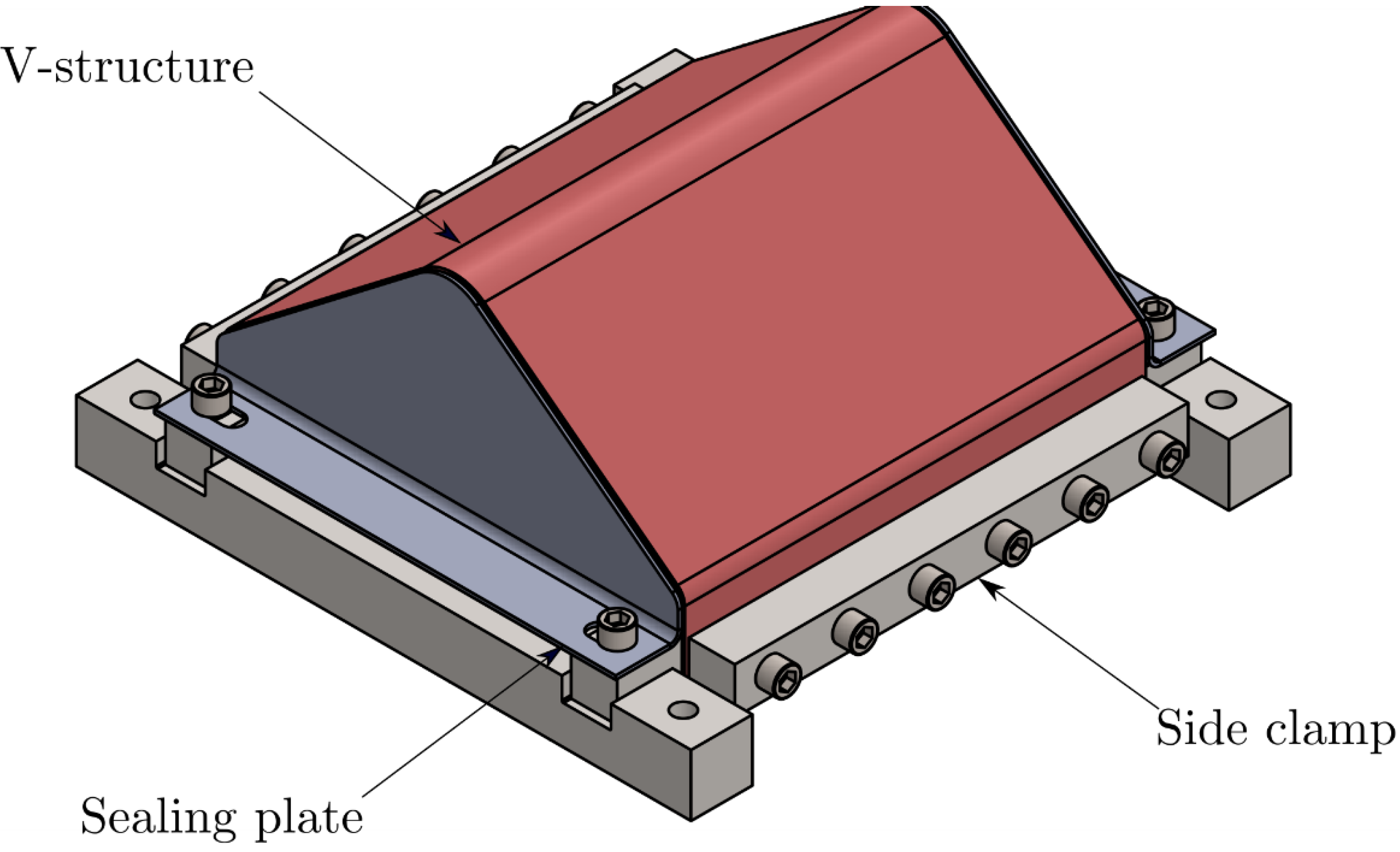
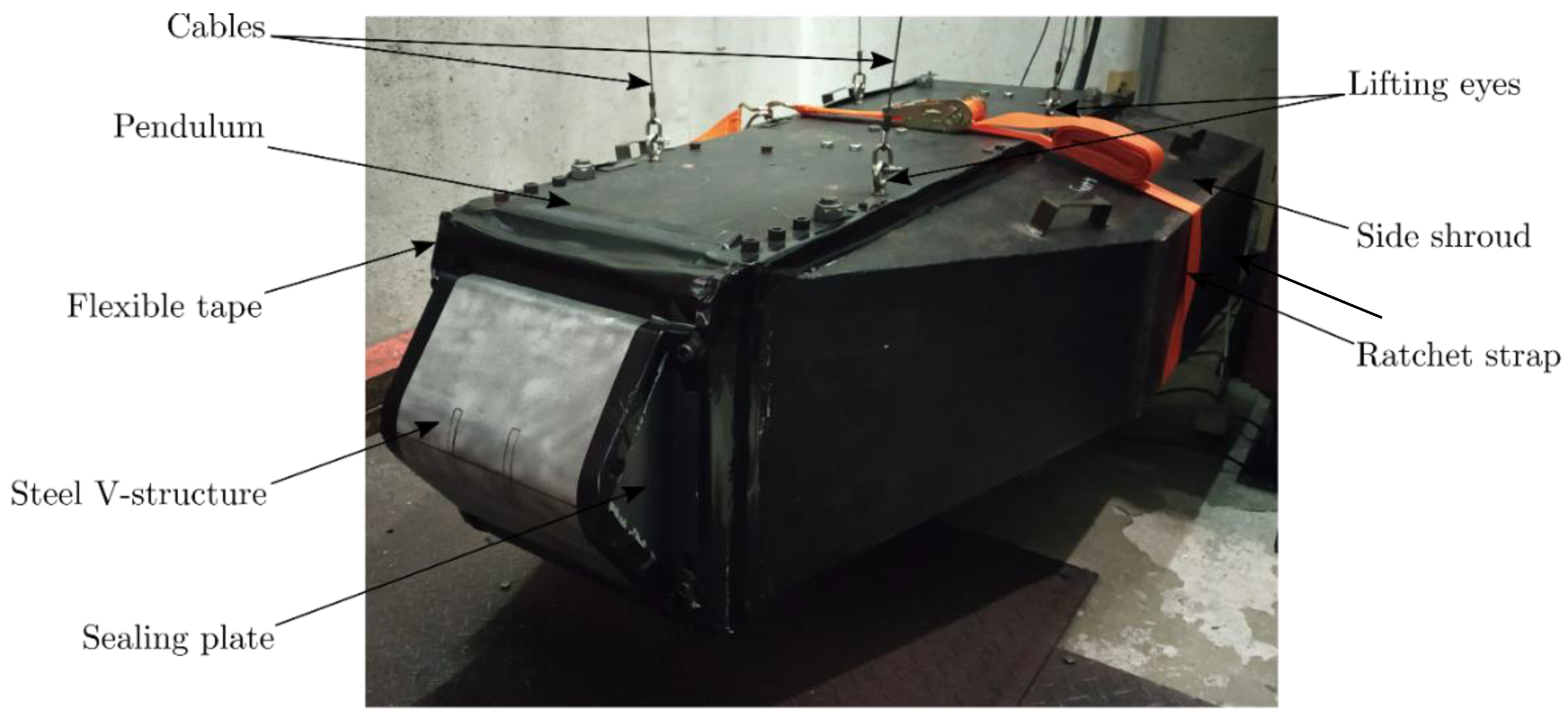
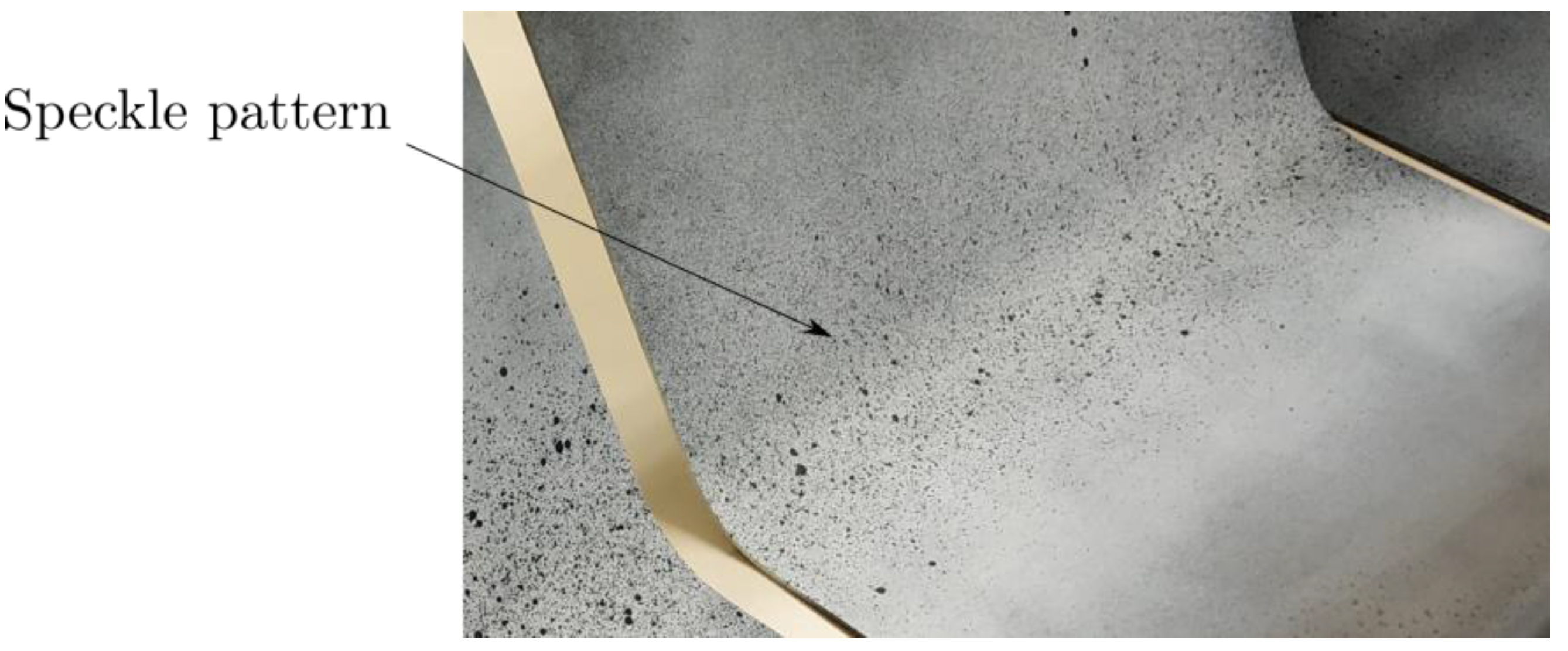
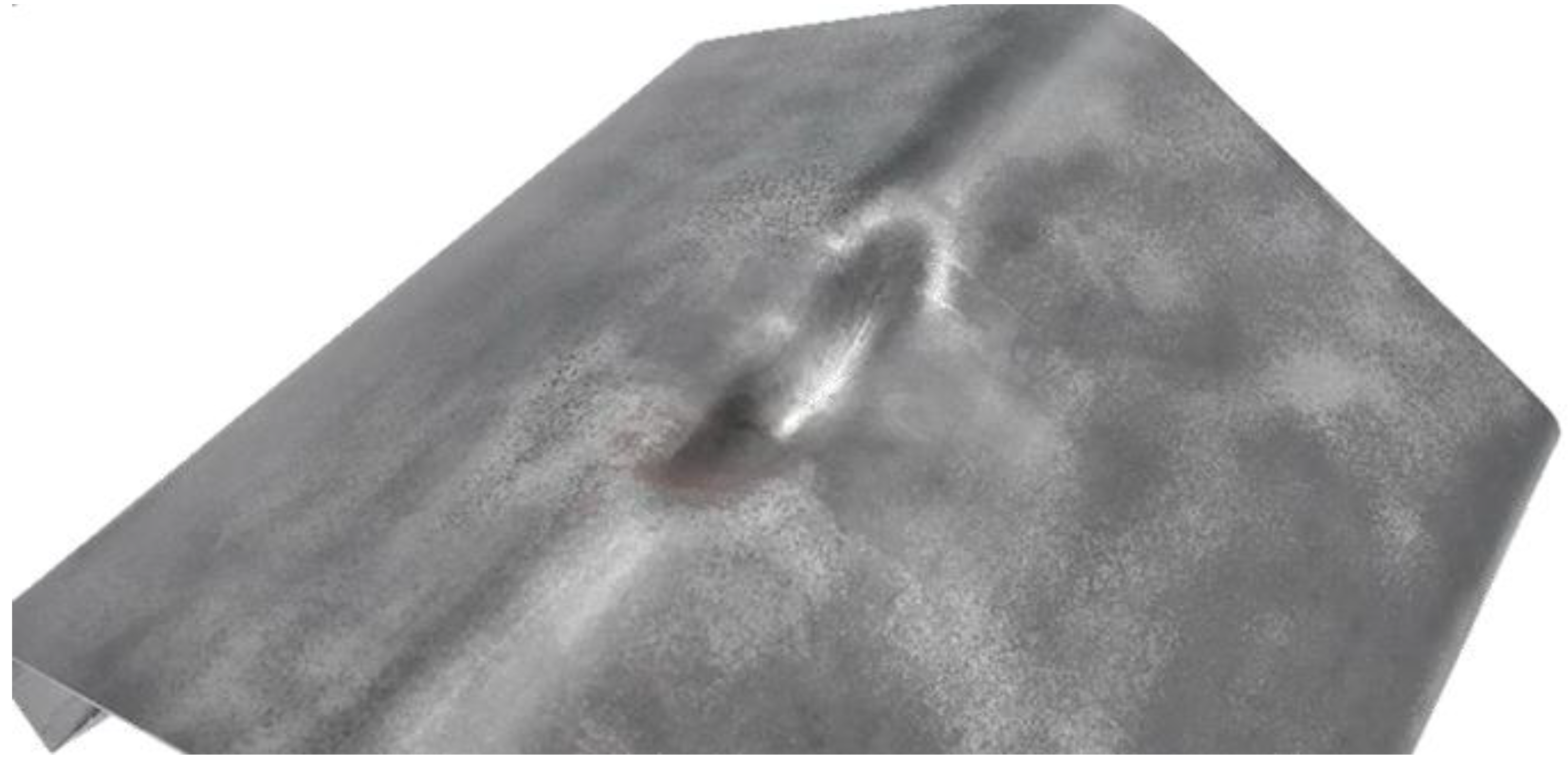
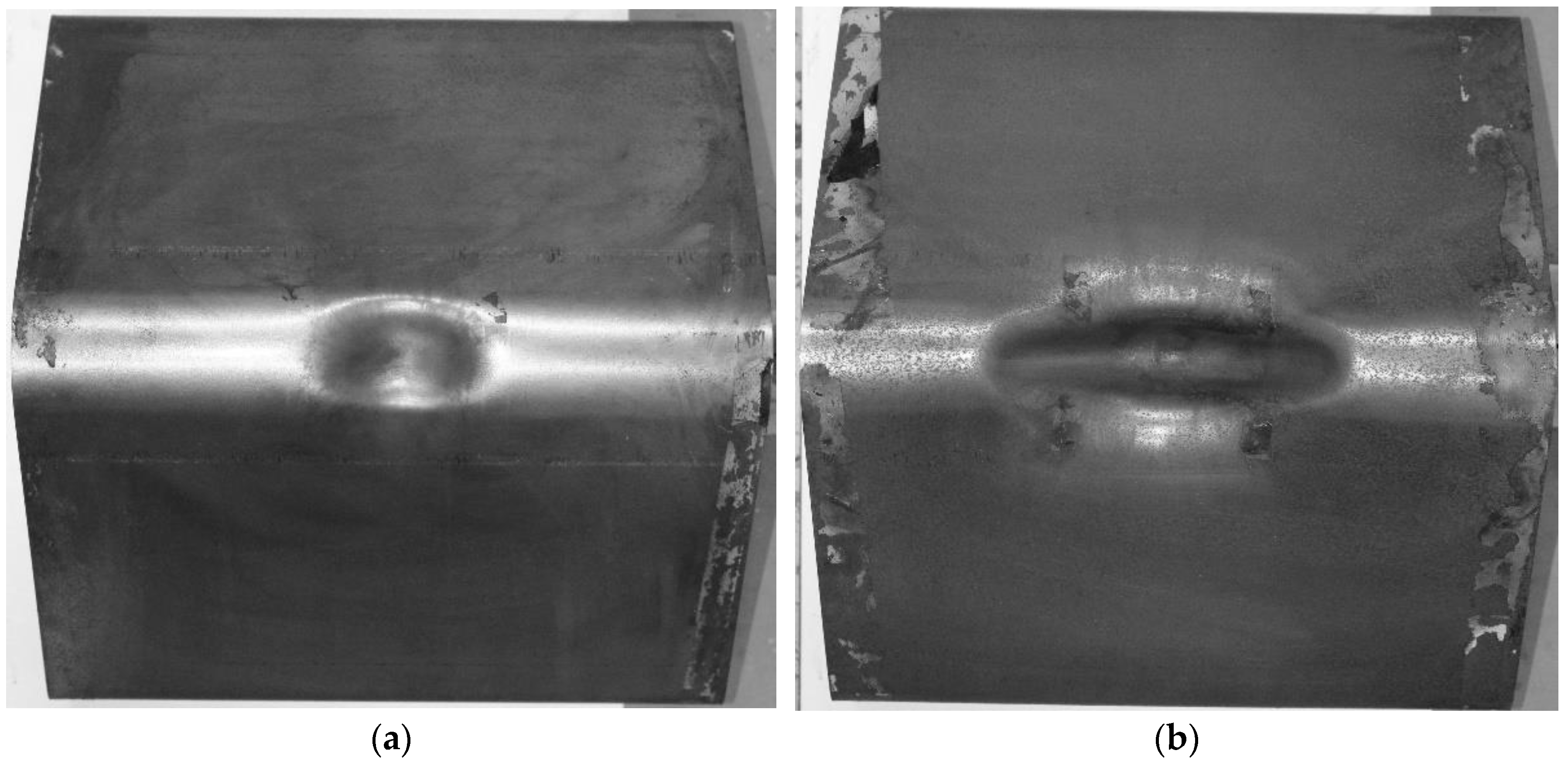
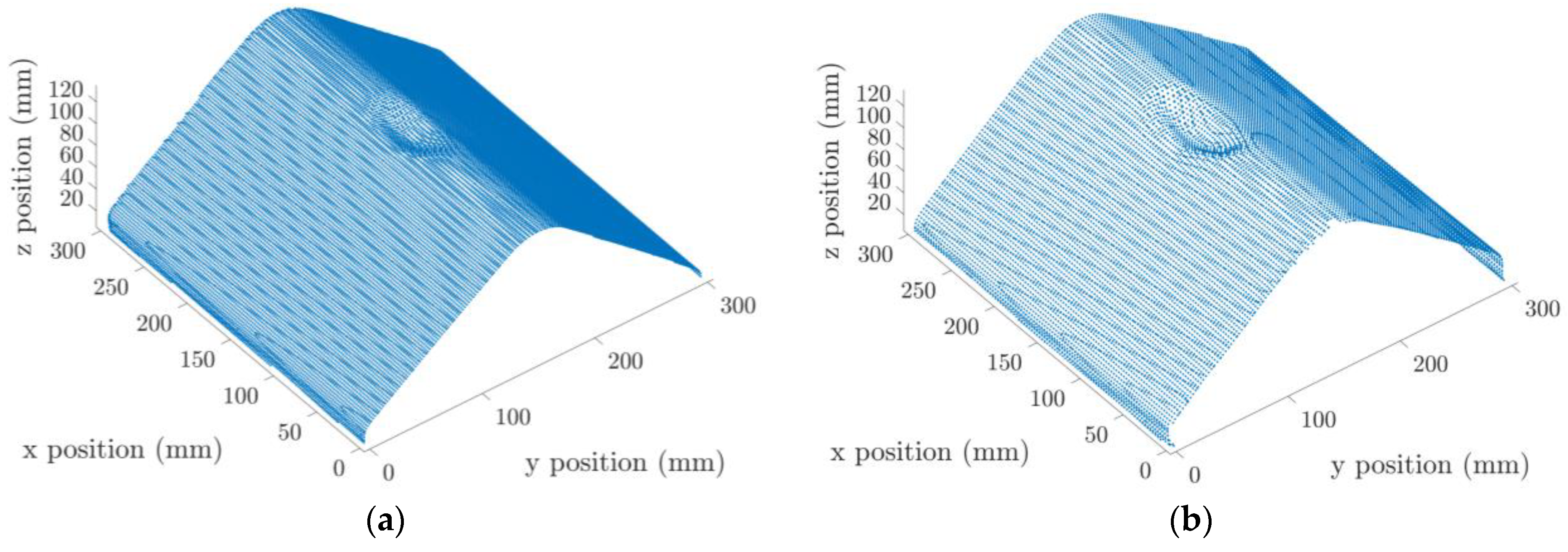

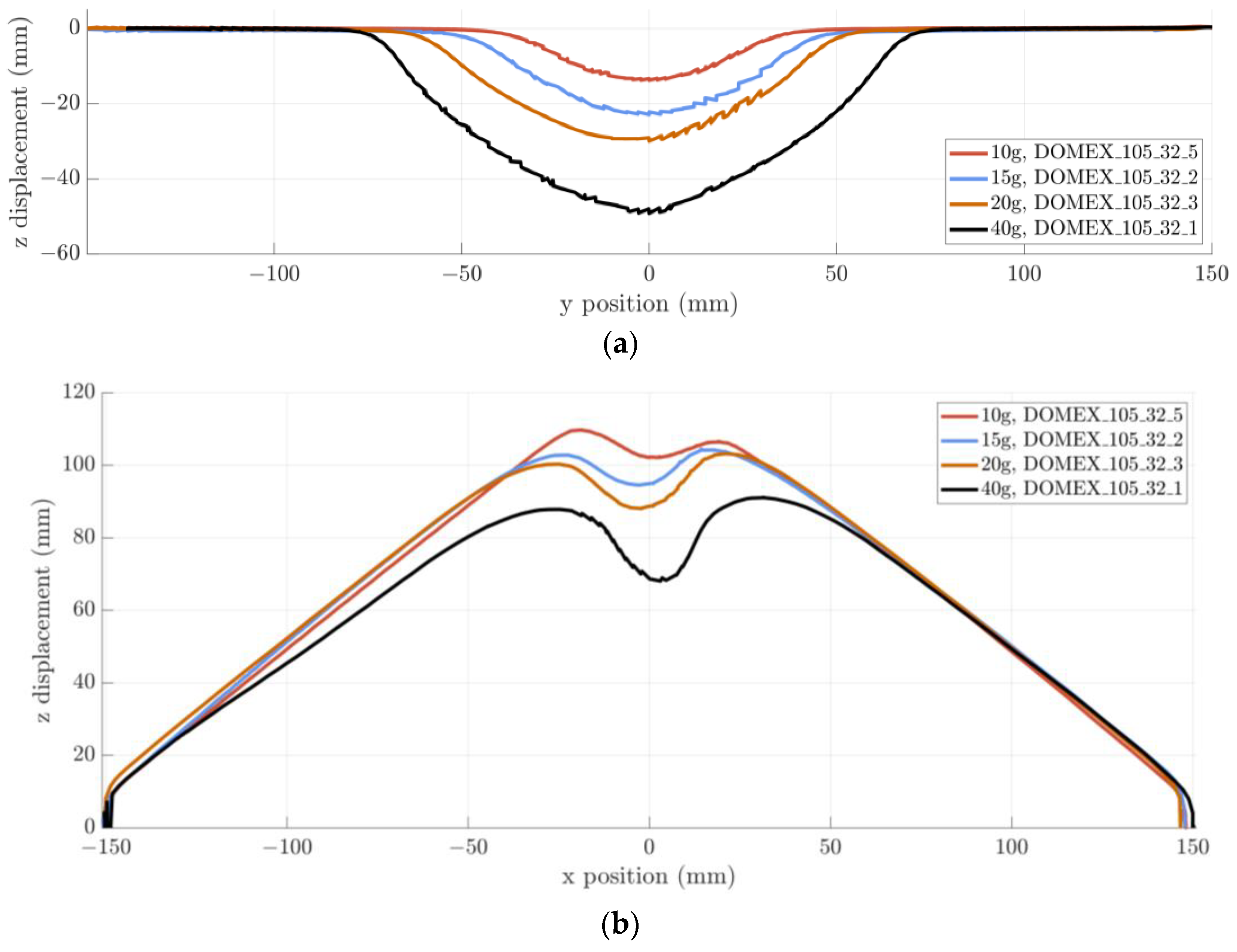
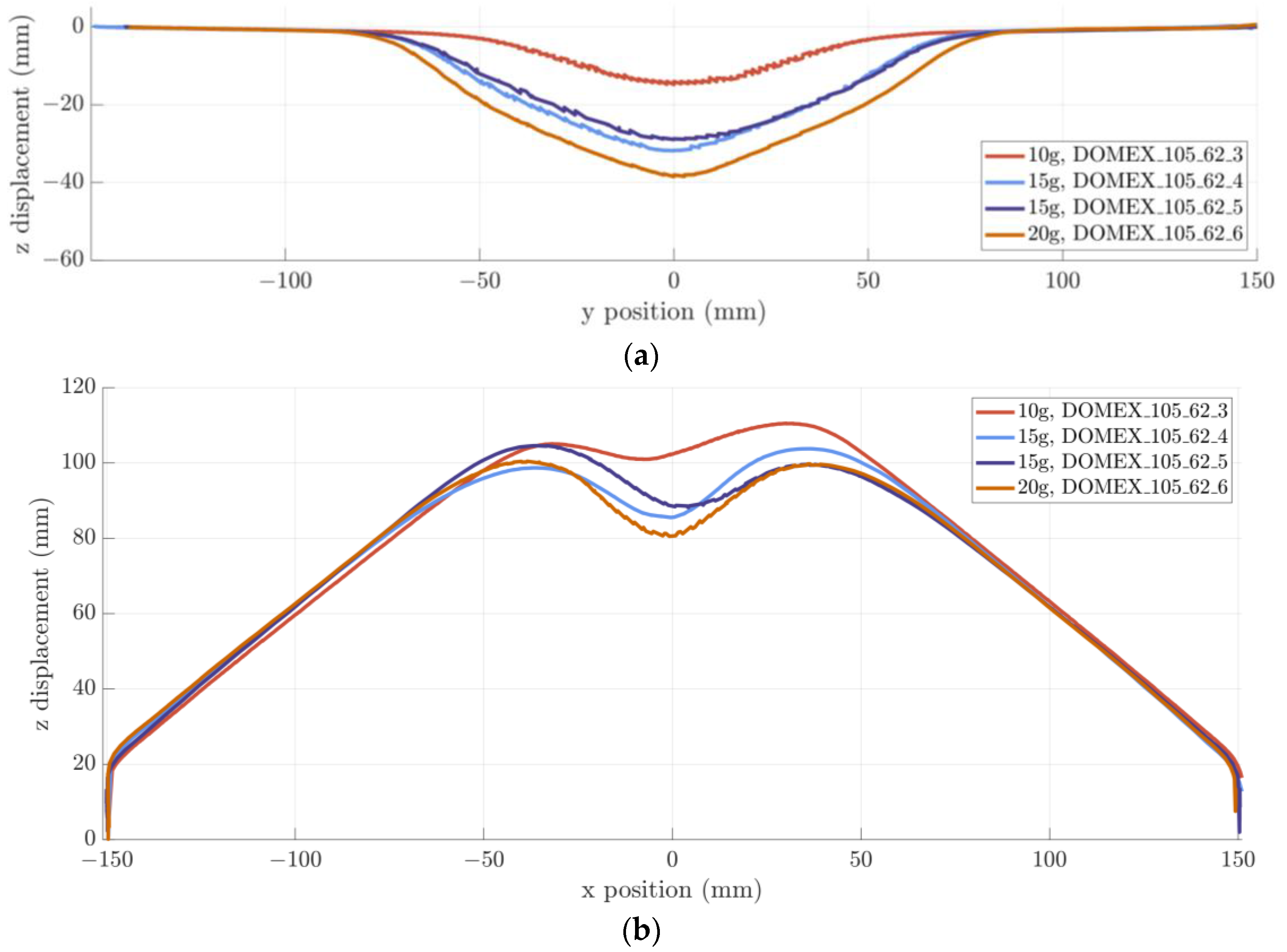

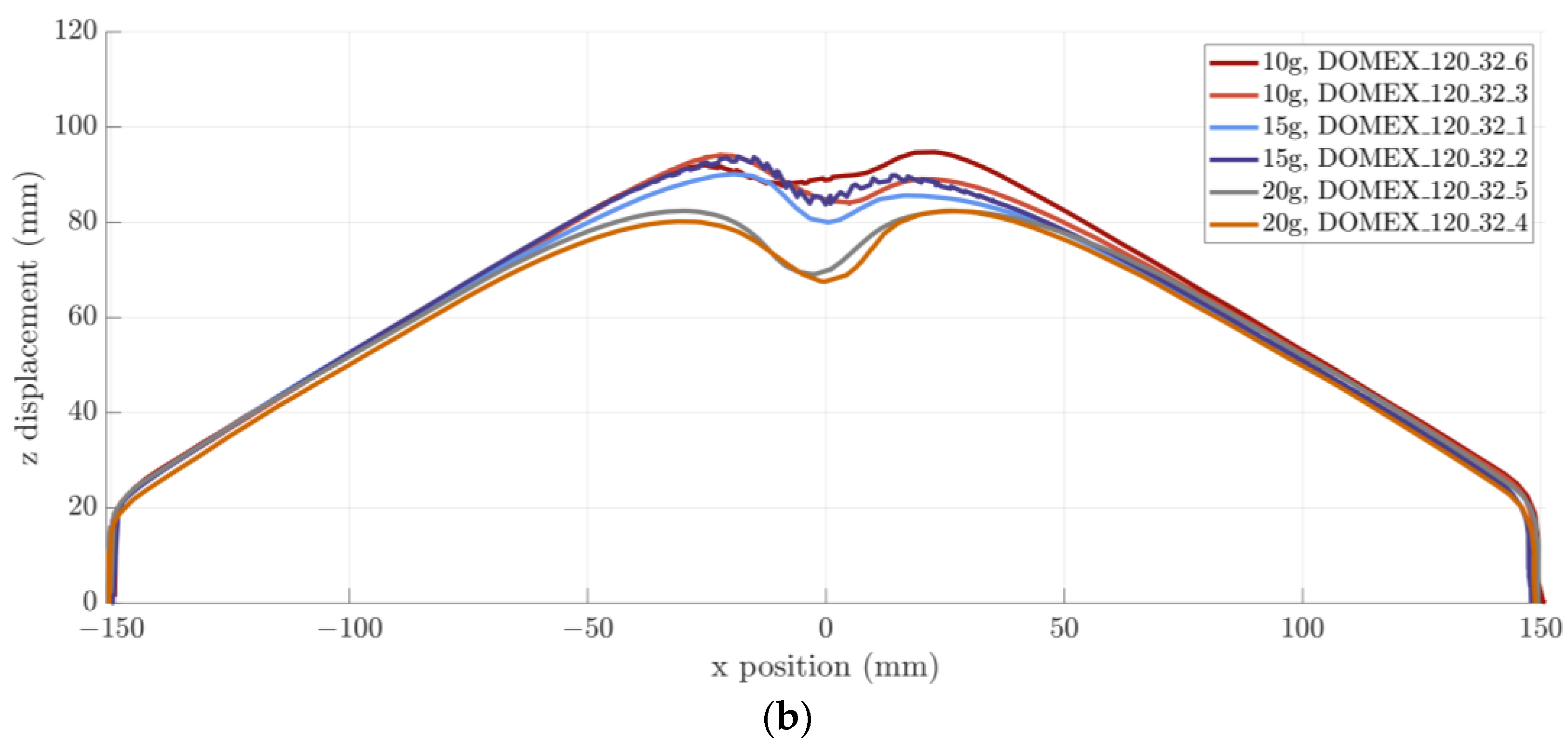

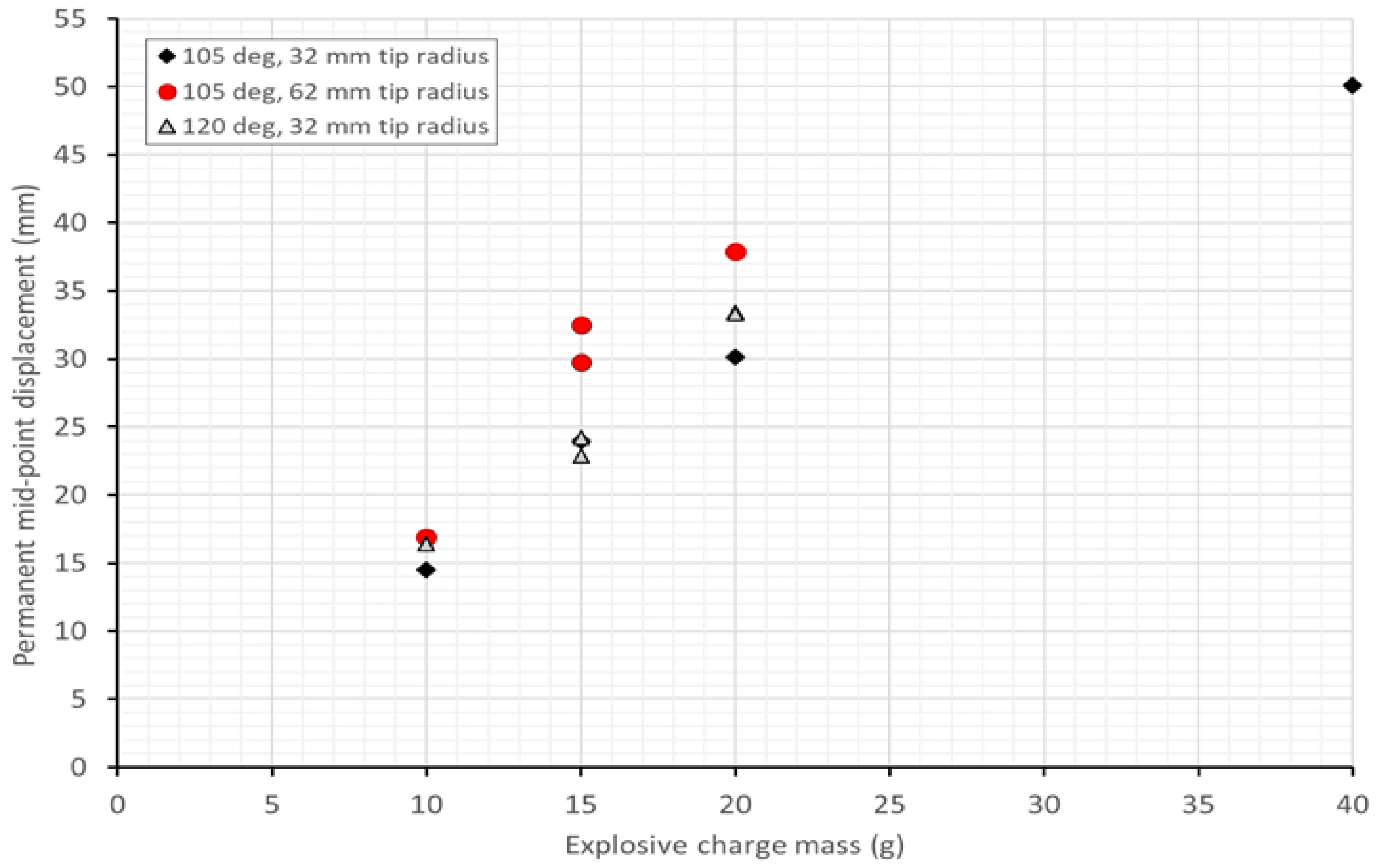

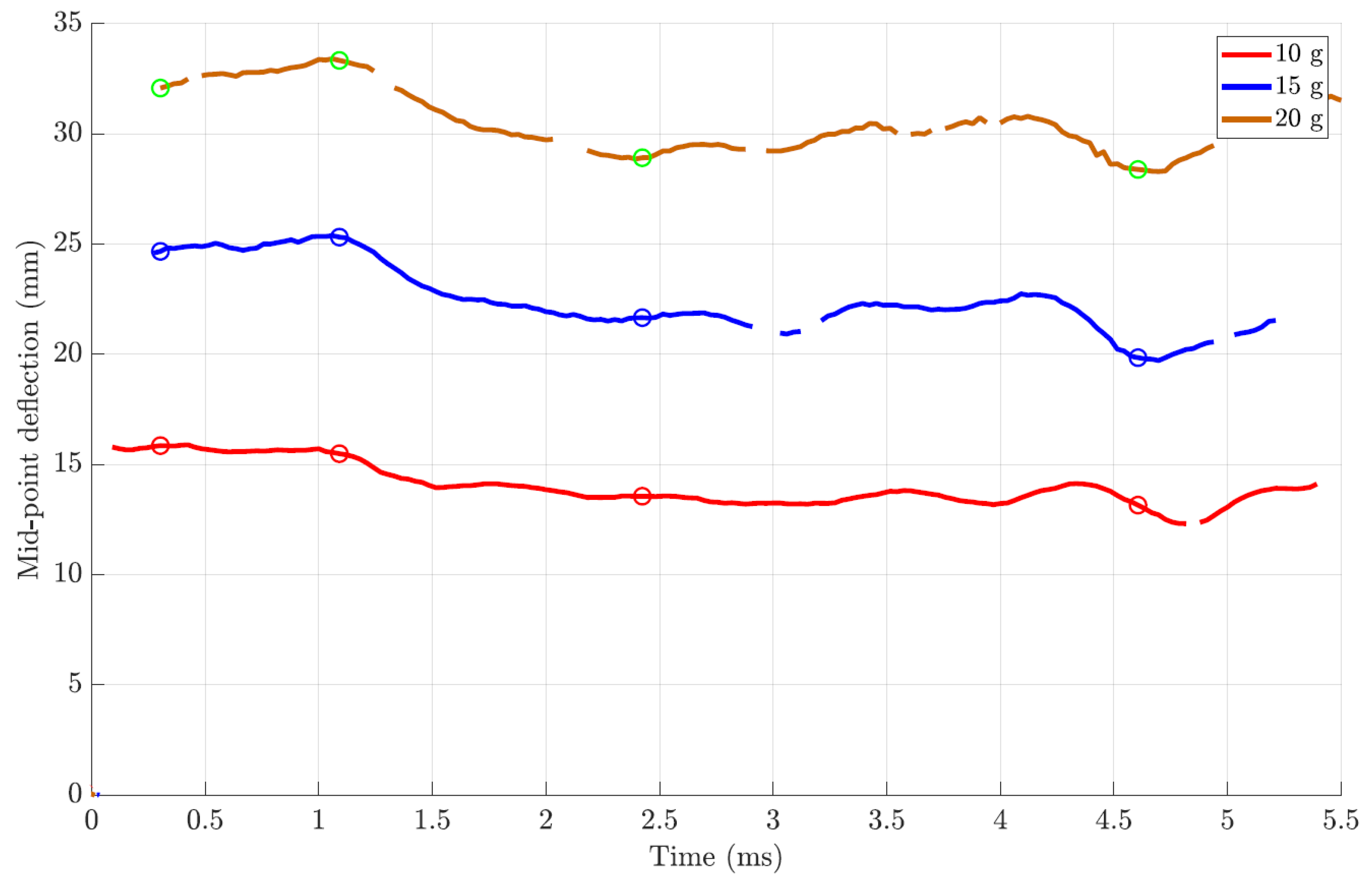

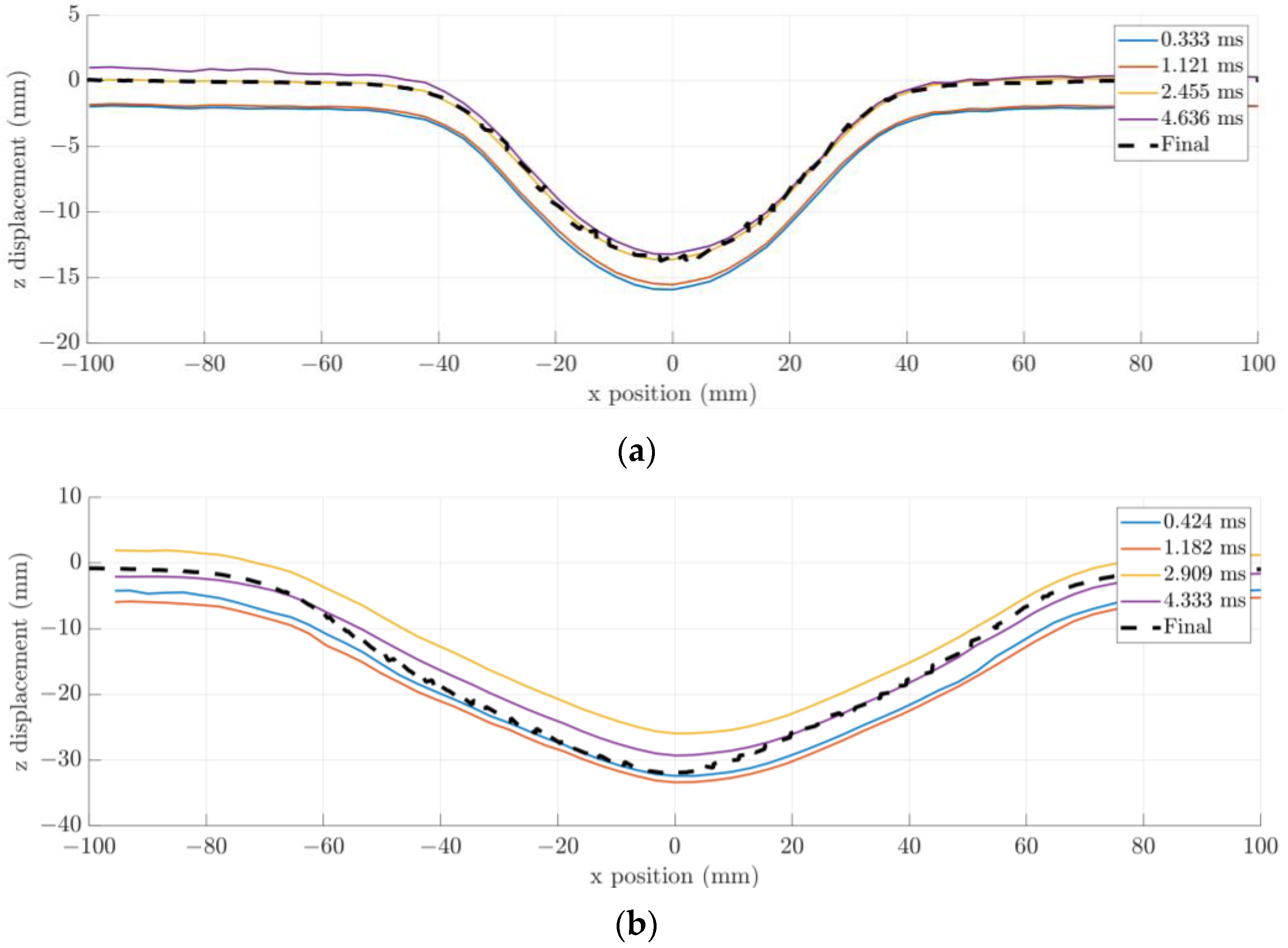

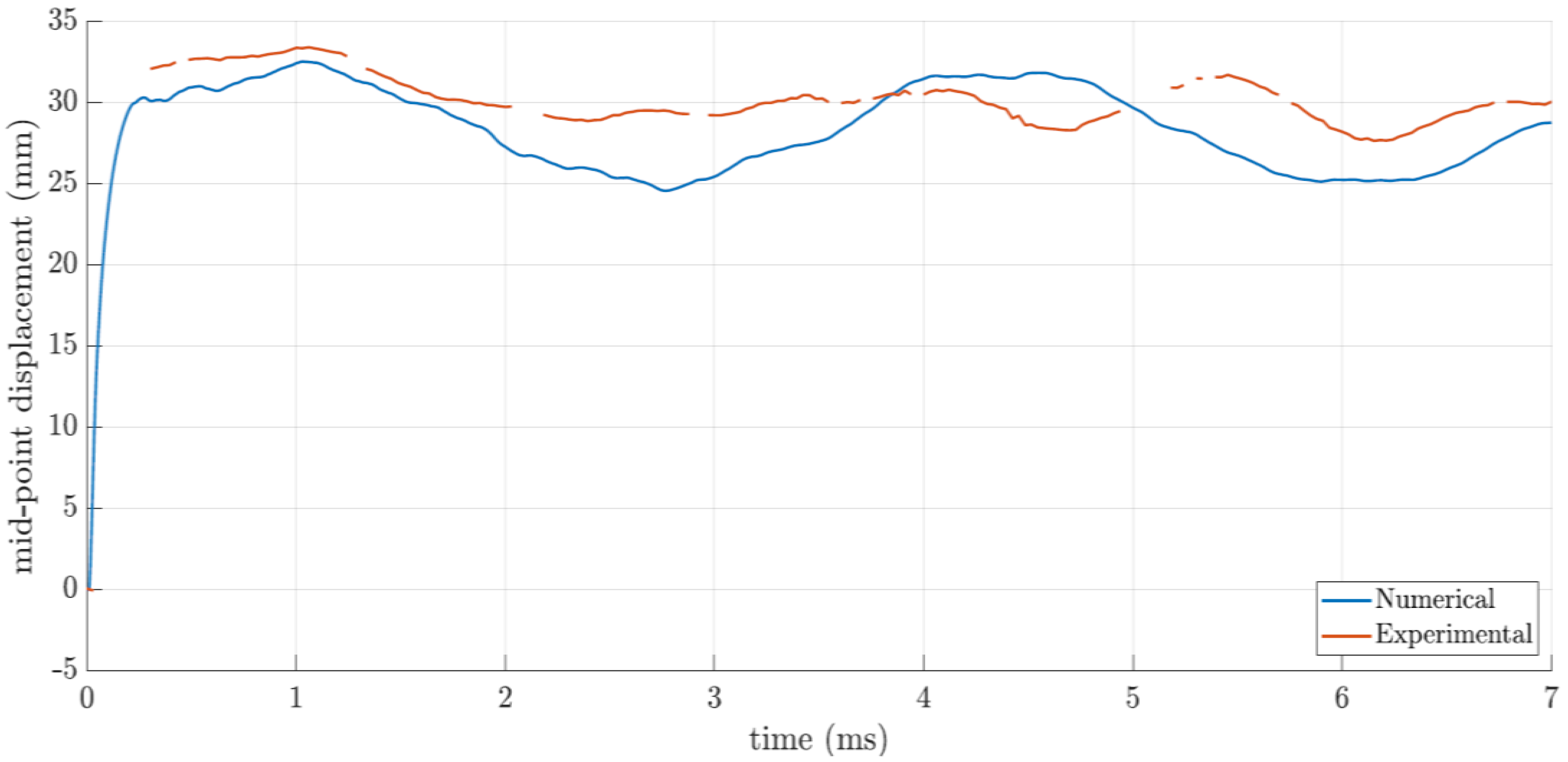
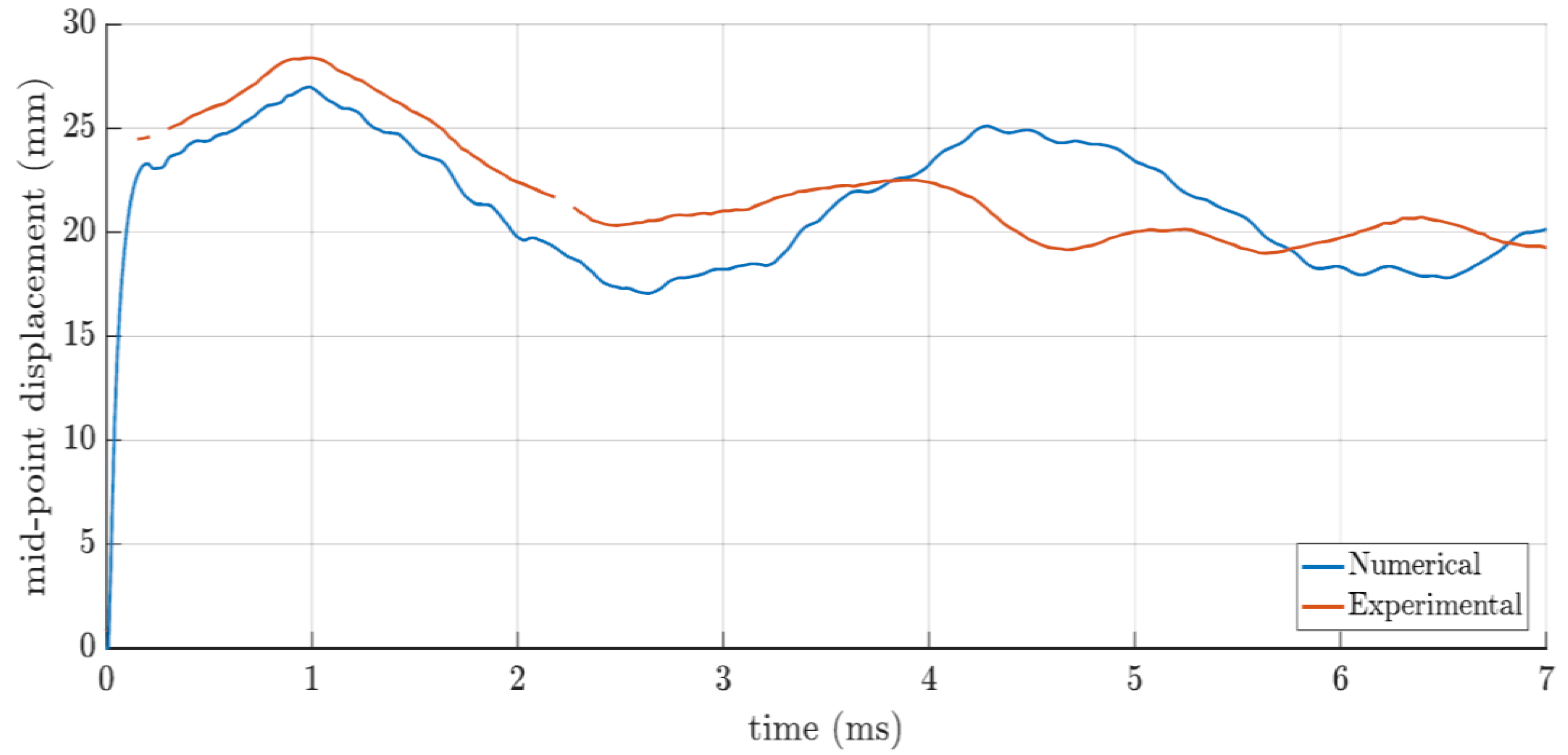
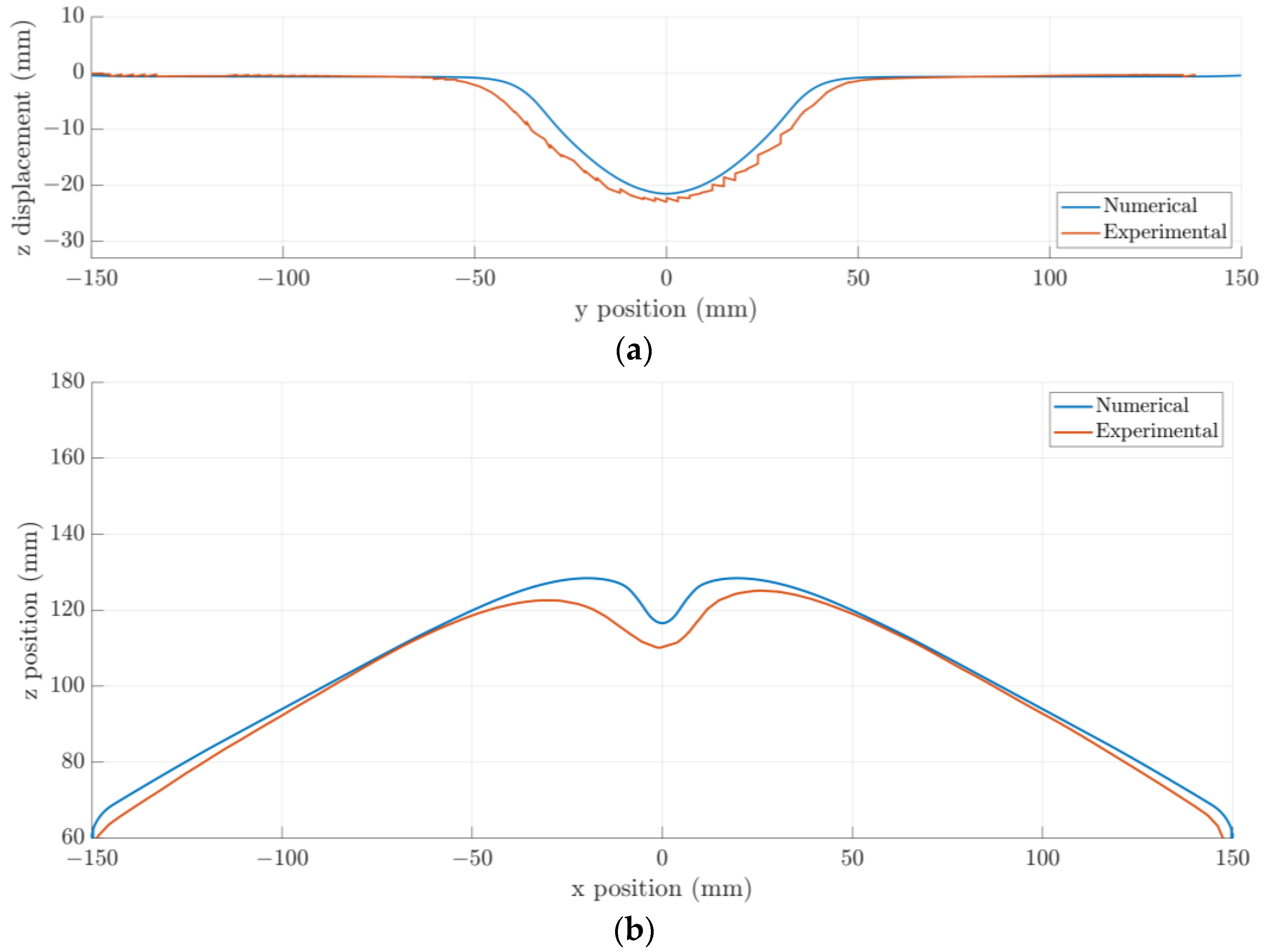
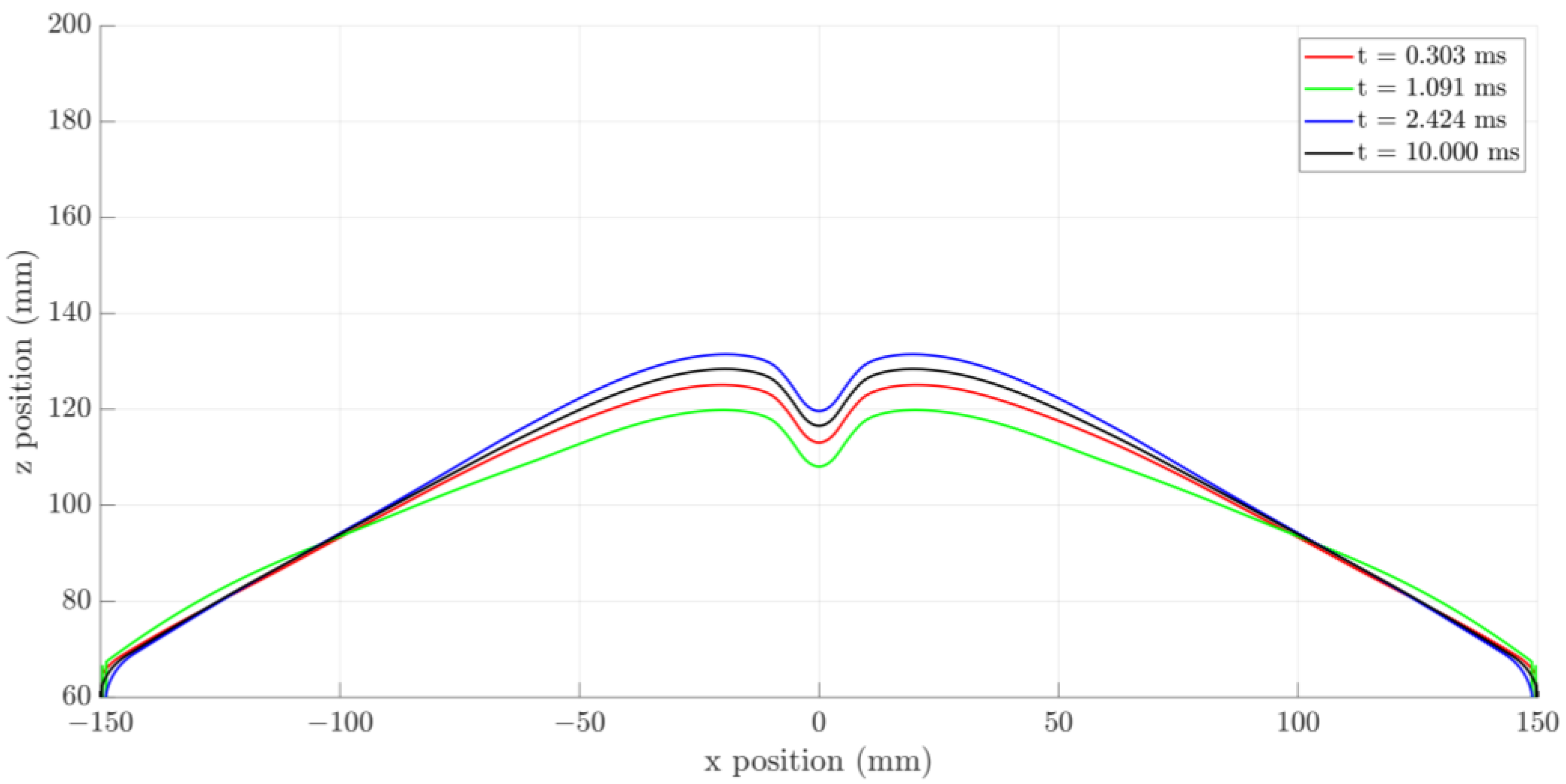
Disclaimer/Publisher’s Note: The statements, opinions and data contained in all publications are solely those of the individual author(s) and contributor(s) and not of MDPI and/or the editor(s). MDPI and/or the editor(s) disclaim responsibility for any injury to people or property resulting from any ideas, methods, instructions or products referred to in the content. |
© 2023 by the authors. Licensee MDPI, Basel, Switzerland. This article is an open access article distributed under the terms and conditions of the Creative Commons Attribution (CC BY) license (https://creativecommons.org/licenses/by/4.0/).
Share and Cite
Shekhar, V.R.; von Klemperer, C.J.; Langdon, G.S. The Damage and Impulse Transfer Characteristics of Flexible Steel V-Structures with Large Bend Radii. Appl. Sci. 2023, 13, 1293. https://doi.org/10.3390/app13031293
Shekhar VR, von Klemperer CJ, Langdon GS. The Damage and Impulse Transfer Characteristics of Flexible Steel V-Structures with Large Bend Radii. Applied Sciences. 2023; 13(3):1293. https://doi.org/10.3390/app13031293
Chicago/Turabian StyleShekhar, Vinay R., Christopher J. von Klemperer, and Genevieve S. Langdon. 2023. "The Damage and Impulse Transfer Characteristics of Flexible Steel V-Structures with Large Bend Radii" Applied Sciences 13, no. 3: 1293. https://doi.org/10.3390/app13031293
APA StyleShekhar, V. R., von Klemperer, C. J., & Langdon, G. S. (2023). The Damage and Impulse Transfer Characteristics of Flexible Steel V-Structures with Large Bend Radii. Applied Sciences, 13(3), 1293. https://doi.org/10.3390/app13031293







